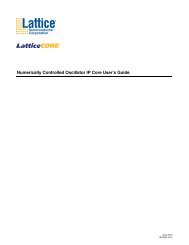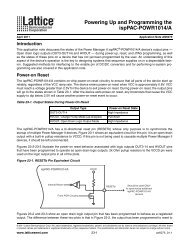DS1036 - Platform Manager Data Sheet - Lattice Semiconductor
DS1036 - Platform Manager Data Sheet - Lattice Semiconductor
DS1036 - Platform Manager Data Sheet - Lattice Semiconductor
You also want an ePaper? Increase the reach of your titles
YUMPU automatically turns print PDFs into web optimized ePapers that Google loves.
31<br />
<strong>Platform</strong> <strong>Manager</strong> <strong>Data</strong> <strong>Sheet</strong><br />
VMON Voltage Measurement with the Internal Analog to Digital Converter (ADC)<br />
The <strong>Platform</strong> <strong>Manager</strong> has an internal analog to digital converter that can be used for measuring the voltages at<br />
the VMON inputs. The ADC is also used in closed loop trimming of DC-DC converters. Close loop trimming is covered<br />
later in this document.<br />
Figure 15. ADC Monitoring VMON1 to VMON12<br />
VMON1*<br />
VMON2<br />
VMON3<br />
VMON12*<br />
PVCCA<br />
PVCCINP<br />
ADC<br />
MUX<br />
4<br />
From Closed<br />
Loop Trim<br />
Circuit<br />
Programmable<br />
Analog<br />
Attenuator<br />
5<br />
3 1<br />
5 5<br />
1<br />
From I 2 C<br />
ADC MUX<br />
Register<br />
*VMON1 and VMON9 to VMON12 are single-ended inputs for the 128-pin TQFP package option.<br />
Figure 15 shows the ADC circuit arrangement within the <strong>Platform</strong> <strong>Manager</strong> device. The ADC can measure all analog<br />
input voltages through the multiplexer, ADC MUX. The programmable attenuator between the ADC mux and the<br />
ADC can be configured as divided-by-3 or divided-by-1 (no attenuation). The divided-by-3 setting is used to measure<br />
voltages from 0V to 6V range and divided-by-1 setting is used to measure the voltages from 0V to 2V range.<br />
Note that for the 128-pin TQFP package option, the VMON1 and VMON9 to VMON12 input pins are single-ended<br />
inputs, not differential as shown above.<br />
A microcontroller can place a request for any VMON voltage measurement at any time through the I 2 C bus. Upon<br />
the receipt of an I 2 C command, the ADC will be connected to the I 2 C selected VMON through the ADC MUX. The<br />
ADC output is then latched into the I 2 C readout registers.<br />
Calculation<br />
The algorithm to convert the ADC code to the corresponding voltage takes into consideration the attenuation bit<br />
value. In other words, if the attenuation bit is set, then the 10-bit ADC result is automatically multiplied by 3 to calculate<br />
the actual voltage at that V MON input. Thus, the I 2 C readout register is 12 bits instead of 10 bits. The following<br />
formula can always be used to calculate the actual voltage from the ADC code.<br />
ADC<br />
Internal<br />
Control Signal<br />
Internal<br />
VREF-<br />
2.048V<br />
10<br />
Programmable<br />
Digital<br />
Multiplier<br />
3 1<br />
12<br />
To Closed<br />
Loop Trim<br />
Circuit<br />
To I 2 C<br />
Readout<br />
Register









